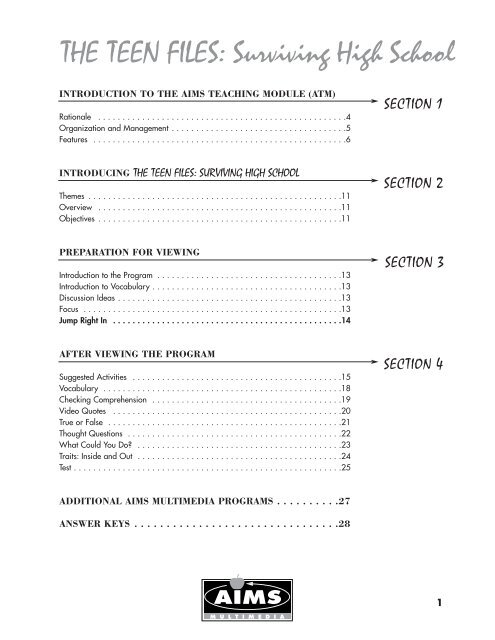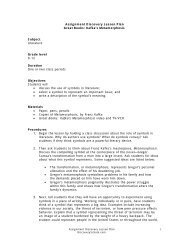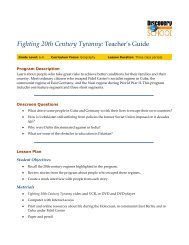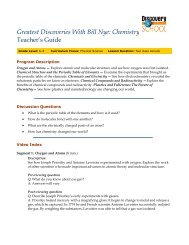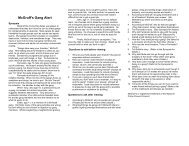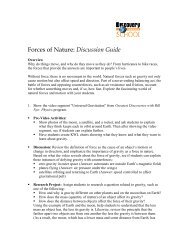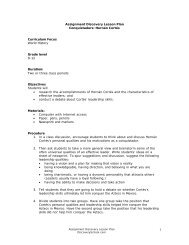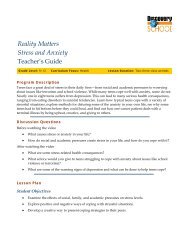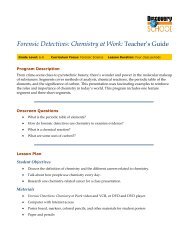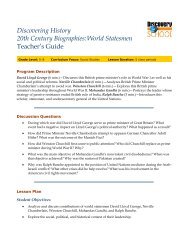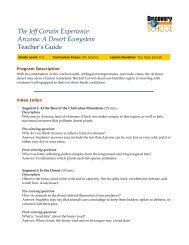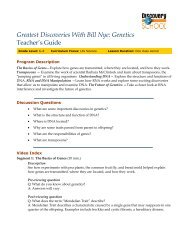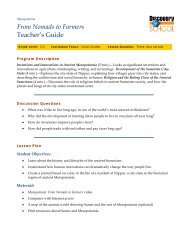THE TEEN FILES: Surviving High School
THE TEEN FILES: Surviving High School
THE TEEN FILES: Surviving High School
Create successful ePaper yourself
Turn your PDF publications into a flip-book with our unique Google optimized e-Paper software.
<strong>THE</strong> <strong>TEEN</strong> <strong>FILES</strong>: <strong>Surviving</strong> <strong>High</strong> <strong>School</strong><br />
INTRODUCTION TO <strong>THE</strong> AIMS TEACHING MODULE (ATM)<br />
Rationale . . . . . . . . . . . . . . . . . . . . . . . . . . . . . . . . . . . . . . . . . . . . . . . . . . .4<br />
Organization and Management . . . . . . . . . . . . . . . . . . . . . . . . . . . . . . . . . . . .5<br />
Features . . . . . . . . . . . . . . . . . . . . . . . . . . . . . . . . . . . . . . . . . . . . . . . . . . . .6<br />
INTRODUCING <strong>THE</strong> <strong>TEEN</strong> <strong>FILES</strong>: SURVIVING HIGH SCHOOL<br />
Themes . . . . . . . . . . . . . . . . . . . . . . . . . . . . . . . . . . . . . . . . . . . . . . . . . . . .11<br />
Overview . . . . . . . . . . . . . . . . . . . . . . . . . . . . . . . . . . . . . . . . . . . . . . . . . .11<br />
Objectives . . . . . . . . . . . . . . . . . . . . . . . . . . . . . . . . . . . . . . . . . . . . . . . . . .11<br />
PREPARATION FOR VIEWING<br />
Introduction to the Program . . . . . . . . . . . . . . . . . . . . . . . . . . . . . . . . . . . . . .13<br />
Introduction to Vocabulary . . . . . . . . . . . . . . . . . . . . . . . . . . . . . . . . . . . . . . .13<br />
Discussion Ideas . . . . . . . . . . . . . . . . . . . . . . . . . . . . . . . . . . . . . . . . . . . . . .13<br />
Focus . . . . . . . . . . . . . . . . . . . . . . . . . . . . . . . . . . . . . . . . . . . . . . . . . . . . .13<br />
Jump Right In . . . . . . . . . . . . . . . . . . . . . . . . . . . . . . . . . . . . . . . . . . . . . . .14<br />
AFTER VIEWING <strong>THE</strong> PROGRAM<br />
Suggested Activities . . . . . . . . . . . . . . . . . . . . . . . . . . . . . . . . . . . . . . . . . . .15<br />
Vocabulary . . . . . . . . . . . . . . . . . . . . . . . . . . . . . . . . . . . . . . . . . . . . . . . . .18<br />
Checking Comprehension . . . . . . . . . . . . . . . . . . . . . . . . . . . . . . . . . . . . . . .19<br />
Video Quotes . . . . . . . . . . . . . . . . . . . . . . . . . . . . . . . . . . . . . . . . . . . . . . .20<br />
True or False . . . . . . . . . . . . . . . . . . . . . . . . . . . . . . . . . . . . . . . . . . . . . . . .21<br />
Thought Questions . . . . . . . . . . . . . . . . . . . . . . . . . . . . . . . . . . . . . . . . . . . .22<br />
What Could You Do? . . . . . . . . . . . . . . . . . . . . . . . . . . . . . . . . . . . . . . . . . .23<br />
Traits: Inside and Out . . . . . . . . . . . . . . . . . . . . . . . . . . . . . . . . . . . . . . . . . .24<br />
Test . . . . . . . . . . . . . . . . . . . . . . . . . . . . . . . . . . . . . . . . . . . . . . . . . . . . . . .25<br />
ADDITIONAL AIMS MULTIMEDIA PROGRAMS . . . . . . . . . .27<br />
ANSWER KEYS . . . . . . . . . . . . . . . . . . . . . . . . . . . . . . . .28<br />
SECTION 1<br />
SECTION 2<br />
SECTION 3<br />
SECTION 4<br />
1
© Copyright 1999 AIMS Multimedia<br />
All Rights Reserved. No part of this work may be reproduced or transmitted without written permission of AIMS<br />
Multimedia with these exceptions: Persons or schools purchasing this AIMS Teaching Module may reproduce<br />
consumable ATM pages, identified in Section 4, for student or classroom use.<br />
AIMS Multimedia is a leading producer and distributor of educational programs serving schools and libraries for<br />
nearly 40 years. AIMS draws upon the most up-to-date knowledge, existing and emerging technologies, and all of<br />
the instructional and pedagogical resources available to develop and distribute educational programs<br />
in film, videocassette, laserdisc, CD-ROM and CD-i formats.<br />
2<br />
Persons or schools interested in obtaining additional copies of this AIMS Teaching Module, please contact:<br />
AIMS Multimedia<br />
1-800-FOR-AIMS<br />
1-800-367-2467<br />
© Copyright 2000 AIMS Multimedia
Congratulations!<br />
You have chosen a learning program<br />
that will actively motivate your students<br />
AND provide you with easily accessible<br />
and easily manageable instructional<br />
guidelines designed to make your<br />
teaching role efficient and rewarding.<br />
The AIMS Teaching Module provides<br />
you with a video program keyed to your<br />
classroom curriculum, instructions and<br />
guidelines for use, plus a comprehensive<br />
teaching program containing a<br />
wide range of activities and ideas for<br />
interaction between all content areas.<br />
Our authors, educators, and consultants<br />
have written and reviewed the AIMS<br />
Teaching Modules to align with the<br />
Educate America Act: Goals 2000.<br />
This ATM, with its clear definition of<br />
manageability, both in the classroom<br />
and beyond, allows you to tailor specific<br />
activities to meet all of your classroom<br />
needs.<br />
© Copyright 2000 AIMS Multimedia<br />
3
4<br />
RATIONALE<br />
In today’s classrooms, educational pedagogy<br />
is often founded on Benjamin S.<br />
Bloom’s “Six Levels of Cognitive<br />
Complexity.” The practical application<br />
of Bloom’s Taxonomy is to evaluate students’<br />
thinking skills on these levels,<br />
from the simple to the complex:<br />
Knowledge (rote memory skills),<br />
Comprehension (the ability to relate or<br />
retell), Application (the ability to apply<br />
knowledge outside its origin), Analysis<br />
(relating and differentiating parts of a<br />
whole), Synthesis (relating parts to a<br />
whole), and Evaluation (making a judgment<br />
or formulating an opinion).<br />
The AIMS Teaching Module is designed<br />
to facilitate these intellectual capabilities,<br />
AND to integrate classroom experiences<br />
and assimilation of learning<br />
with the students’ life experiences, realities,<br />
and expectations. AIMS’ learner<br />
verification studies prove that our AIMS<br />
Teaching Modules help students to<br />
absorb, retain, and to demonstrate ability<br />
to use new knowledge in their world.<br />
Our educational materials are written<br />
and designed for today’s classroom,<br />
which incorporates a wide range of<br />
intellectual, cultural, physical, and emotional<br />
diversities.<br />
© Copyright 2000 AIMS Multimedia
ORGANIZATION AND<br />
MANAGEMENT<br />
To facilitate ease in classroom manageability,<br />
the AIMS Teaching Module is<br />
organized in four sections. You are<br />
reading Section 1, Introduction to the<br />
Aims Teaching Module (ATM).<br />
SECTION 2,<br />
INTRODUCING THIS ATM<br />
will give you the specific information<br />
you need to integrate the program into<br />
your classroom curriculum.<br />
SECTION 3,<br />
PREPARATION FOR VIEWING<br />
provides suggestions and strategies for<br />
motivation, language preparedness,<br />
readiness, and focus prior to viewing<br />
the program with your students.<br />
SECTION 4,<br />
AFTER VIEWING <strong>THE</strong> PROGRAM<br />
provides suggestions for additional<br />
activities plus an assortment of consumable<br />
assessment and extended activities,<br />
designed to broaden comprehension of<br />
the topic and to make connections to<br />
other curriculum content areas.<br />
© Copyright 2000 AIMS Multimedia<br />
5
6<br />
FEATURES<br />
INTRODUCING EACH ATM<br />
SECTION 2<br />
Your AIMS Teaching Module is<br />
designed to accompany a video program<br />
written and produced by some of<br />
the world’s most credible and creative<br />
writers and producers of educational<br />
programming. To facilitate diversity and<br />
flexibility in your classroom, your AIMS<br />
Teaching Module features these components:<br />
Themes<br />
The Major Theme tells how this AIMS<br />
Teaching Module is keyed into the curriculum.<br />
Related Themes offer suggestions<br />
for interaction with other<br />
curriculum content areas, enabling<br />
teachers to use the teaching module to<br />
incorporate the topic into a variety of<br />
learning areas.<br />
Overview<br />
The Overview provides a synopsis of<br />
content covered in the video program.<br />
Its purpose is to give you a summary of<br />
the subject matter and to enhance your<br />
introductory preparation.<br />
Objectives<br />
The ATM learning objectives provide<br />
guidelines for teachers to assess what<br />
learners can be expected to gain from<br />
each program. After completion of the<br />
AIMS Teaching Module, your students<br />
will be able to demonstrate dynamic<br />
and applied comprehension of the<br />
topic.<br />
© Copyright 2000 AIMS Multimedia
PREPARATION FOR VIEWING<br />
SECTION 3<br />
In preparation for viewing the video<br />
program, the AIMS Teaching Module<br />
offers activity and/or discussion<br />
ideas that you may use in any order<br />
or combination.<br />
Introduction To The Program<br />
Introduction to the Program is<br />
designed to enable students to recall<br />
or relate prior knowledge about the<br />
topic and to prepare them for what<br />
they are about to learn.<br />
Introduction To Vocabulary<br />
Introduction to Vocabulary is a<br />
review of language used in the program:<br />
words, phrases, usage. This<br />
vocabulary introduction is designed to<br />
ensure that all learners, including limited<br />
English proficiency learners, will<br />
have full understanding of the language<br />
usage in the content of the program.<br />
Discussion Ideas<br />
Discussion Ideas are designed to help<br />
you assess students’ prior knowledge<br />
about the topic and to give students a<br />
preview of what they will learn.<br />
Active discussion stimulates interest in<br />
a subject and can motivate even the<br />
most reluctant learner. Listening, as<br />
well as speaking, is active participation.<br />
Encourage your students to participate<br />
at the rate they feel<br />
comfortable. Model sharing personal<br />
experiences when applicable, and<br />
model listening to students’ ideas and<br />
opinions.<br />
Focus<br />
Help learners set a purpose for<br />
watching the program with Focus,<br />
designed to give students a focal<br />
point for comprehension continuity.<br />
Jump Right In<br />
Jump Right In provides abbreviated<br />
instructions for quick management of<br />
the program.<br />
© Copyright 2000 AIMS Multimedia<br />
AFTER VIEWING <strong>THE</strong> PROGRAM<br />
SECTION 4<br />
After your students have viewed the<br />
program, you may introduce any or<br />
all of these activities to interact with<br />
other curriculum content areas, provide<br />
reinforcement, assess comprehension<br />
skills, or provide hands-on<br />
and in-depth extended study of the<br />
topic.<br />
7
SUGGESTED<br />
ACTIVITIES<br />
The Suggested Activities offer ideas<br />
for activities you can direct in the<br />
classroom or have your students complete<br />
independently, in pairs, or in<br />
small work groups after they have<br />
viewed the program. To accommodate<br />
your range of classroom needs,<br />
the activities are organized into skills<br />
categories. Their labels will tell you<br />
how to identify each activity and help<br />
you correlate it into your classroom<br />
curriculum. To help you schedule your<br />
classroom lesson time, the AIMS<br />
hourglass gives you an estimate of the<br />
time each activity should require.<br />
Some of the activities fall into these<br />
categories:<br />
Meeting Individual<br />
Needs<br />
These activities are designed to aid in<br />
classroom continuity. Reluctant learners<br />
and learners acquiring English<br />
will benefit from these activities<br />
geared to enhance comprehension of<br />
language in order to fully grasp content<br />
meaning.<br />
MATH<br />
Curriculum<br />
Connections<br />
Many of the suggested activities are<br />
intended to integrate the content of<br />
the ATM program into other content<br />
areas of the classroom curriculum.<br />
These cross-connections turn the<br />
classroom teaching experience into a<br />
whole learning experience.<br />
8<br />
Critical Thinking<br />
Critical Thinking activities are<br />
designed to stimulate learners’ own<br />
opinions and ideas. These activities<br />
require students to use the thinking<br />
process to discern fact from opinion,<br />
consider their own problems and formulate<br />
possible solutions, draw conclusions,<br />
discuss cause and effect, or<br />
combine what they already know<br />
with what they have learned to make<br />
inferences.<br />
Cultural Diversity<br />
Each AIMS Teaching Module has an<br />
activity called Cultural Awareness,<br />
Cultural Diversity, or Cultural<br />
Exchange that encourages students to<br />
share their backgrounds, cultures,<br />
heritage, or knowledge of other countries,<br />
customs, and language.<br />
Hands On<br />
These are experimental or tactile<br />
activities that relate directly to the<br />
material taught in the program.Your<br />
students will have opportunities to<br />
make discoveries and formulate ideas<br />
on their own, based on what they<br />
learn in this unit.<br />
Writing<br />
Every AIMS Teaching Module will<br />
contain an activity designed for students<br />
to use the writing process to<br />
express their ideas about what they<br />
have learned. The writing activity<br />
may also help them to make the connection<br />
between what they are learning<br />
in this unit and how it applies to<br />
other content areas.<br />
© Copyright 2000 AIMS Multimedia<br />
In The Newsroom<br />
Each AIMS Teaching Module contains<br />
a newsroom activity designed to help<br />
students make the relationship<br />
between what they learn in the classroom<br />
and how it applies in their<br />
world. The purpose of In The<br />
Newsroom is to actively involve each<br />
class member in a whole learning<br />
experience. Each student will have an<br />
opportunity to perform all of the tasks<br />
involved in production: writing,<br />
researching, producing, directing,<br />
and interviewing as they create their<br />
own classroom news program.<br />
Extended Activities<br />
These activities provide opportunities<br />
for students to work separately or<br />
together to conduct further research,<br />
explore answers to their own questions,<br />
or apply what they have<br />
learned to other media or content<br />
areas.<br />
Link to the World<br />
These activities offer ideas for connecting<br />
learners’ classroom activities<br />
to their community and the rest of the<br />
world.<br />
Culminating Activity<br />
To wrap up the unit, AIMS Teaching<br />
Modules offer suggestions for ways to<br />
reinforce what students have learned<br />
and how they can use their new<br />
knowledge to enhance their world<br />
view.
VOCABULARY<br />
Every ATM contains an activity that<br />
reinforces the meaning and usage of<br />
the vocabulary words introduced in<br />
the program content. Students will<br />
either read or find the definition of<br />
each vocabulary word, then use the<br />
word in a written sentence.<br />
CHECKING<br />
COMPREHENSION<br />
Checking Comprehension is designed<br />
to help you evaluate how well your<br />
students understand, retain, and<br />
recall the information presented in the<br />
AIMS Teaching Module. Depending<br />
on your students’ needs, you may<br />
direct this activity to the whole group<br />
yourself, or you may want to have<br />
students work on the activity page<br />
independently, in pairs, or in small<br />
groups. Students can verify their written<br />
answers through discussion or by<br />
viewing the video a second time. If<br />
you choose, you can reproduce the<br />
answers from your Answer Key or<br />
write the answer choices in a Word<br />
Bank for students to use. Students can<br />
use this completed activity as a study<br />
guide to prepare for the test.<br />
CONSUMABLE<br />
ACTIVITIES<br />
The AIMS Teaching Module provides<br />
a selection of consumable activities,<br />
designed to specifically reinforce the<br />
content of this learning unit.<br />
Whenever applicable, they are<br />
arranged in order from low to high<br />
difficulty level, to allow a seamless<br />
facilitation of the learning process.<br />
You may choose to have students take<br />
these activities home or to work on<br />
them in the classroom independently,<br />
in pairs or in small groups.<br />
CHECKING<br />
VOCABULARY<br />
The Checking Vocabulary activity<br />
provides the opportunity for students<br />
to assess their knowledge of new<br />
vocabulary with this word game or<br />
puzzle. The format of this vocabulary<br />
activity allows students to use the<br />
related words and phrases in a different<br />
context.<br />
© Copyright 2000 AIMS Multimedia<br />
TEST<br />
The AIMS Teaching Module Test permits<br />
you to assess students’ understanding<br />
of what they have learned.<br />
The test is formatted in one of several<br />
standard test formats to give your<br />
students a range of experiences in<br />
test-taking techniques. Be sure to<br />
read, or remind students to read, the<br />
directions carefully and to read each<br />
answer choice before making a<br />
selection. Use the Answer Key to<br />
check their answers.<br />
9
10<br />
ADDITIONAL<br />
AIMS MULTIMEDIA<br />
PROGRAMS<br />
After you have completed this AIMS<br />
Teaching Module you may be interested<br />
in more of the programs that AIMS<br />
offers. This list includes several related<br />
AIMS programs.<br />
ADDITIONAL READING<br />
SUGGESTIONS<br />
AIMS offers a carefully researched list of<br />
other resources that you and your students<br />
may find rewarding.<br />
ANSWER KEY<br />
Reproduces tests and work pages with<br />
answers marked.<br />
© Copyright 2000 AIMS Multimedia
<strong>THE</strong> <strong>TEEN</strong> <strong>FILES</strong>: <strong>Surviving</strong> <strong>High</strong> <strong>School</strong><br />
<strong>THE</strong>MES<br />
<strong>THE</strong> <strong>TEEN</strong> <strong>FILES</strong>: <strong>Surviving</strong> <strong>High</strong><br />
<strong>School</strong> explores the complex world of<br />
social pressures faced by teenagers,<br />
from body image issues such as<br />
bulimia and steroid use, to<br />
depression, suicide, stereotypes,<br />
cliques, isolation and friendship. As<br />
eleven teens from California spend<br />
time getting to know one another,<br />
they discover that most people share<br />
the same needs, wants and feelings—<br />
even when those people appear to be<br />
very different on the surface.<br />
OVERVIEW<br />
In the video <strong>THE</strong> <strong>TEEN</strong> <strong>FILES</strong>:<br />
<strong>Surviving</strong> <strong>High</strong> <strong>School</strong>, eleven students<br />
from Yuba City <strong>High</strong> <strong>School</strong> are<br />
chosen to undergo a series of social<br />
“experiments.” Two popular students<br />
are asked to be outsiders for a day.<br />
The group visits a digital imagining<br />
company to see how magazine ads<br />
give us a deceptive view of the world.<br />
The teens hear about steroid use and<br />
eating disorders. They go on a mountain<br />
retreat to break down the barriers<br />
between them and find out what<br />
they have in common. And finally,<br />
they host a Challenge Day at their<br />
school, sharing what they have<br />
learned with their fellow students.<br />
OBJECTIVES<br />
© Copyright 2000 AIMS Multimedia <strong>THE</strong> <strong>TEEN</strong> <strong>FILES</strong>: <strong>Surviving</strong> <strong>High</strong> <strong>School</strong><br />
�<br />
�<br />
�<br />
�<br />
�<br />
To learn more about the pressures<br />
of high school life and what<br />
causes those pressures.<br />
To examine the various cliques<br />
and stereotypes that exist on<br />
most high school campuses.<br />
To practice using acceptance,<br />
respect and honest communication<br />
in daily interactions.<br />
To focus on what we have in<br />
common, not on what makes us<br />
different.<br />
To find out how we can help one<br />
another by coming together as<br />
friends.<br />
11
Use this page for your individual notes about planning and/or effective ways to manage this<br />
AIMS Teaching Module in your classroom.<br />
12<br />
Our AIMS Multimedia Educational Department welcomes your observations and comments.<br />
Please feel free to address your correspondence to:<br />
AIMS Multimedia<br />
Editorial Department<br />
9710 DeSoto Avenue<br />
Chatsworth, California 91311-4409<br />
© Copyright 2000 AIMS Multimedia <strong>THE</strong> <strong>TEEN</strong> <strong>FILES</strong>: <strong>Surviving</strong> <strong>High</strong> <strong>School</strong>
INTRODUCTION TO<br />
<strong>THE</strong> PROGRAM<br />
Currently, fifty percent of boys and<br />
seventy-five percent of girls are<br />
unhappy with their appearance. One<br />
out of eight teenagers suffers from<br />
depression. Suicide has become the<br />
third leading cause of death for high<br />
school age youth in the United States.<br />
Clearly, surviving high school is<br />
harder than ever before. Only by<br />
coming together and helping each<br />
other can young people overcome the<br />
pain and pressures of youth.<br />
INTRODUCTION TO<br />
VOCABULARY<br />
Before starting the program, write the<br />
following words on the board. Ask<br />
the class to discuss the meaning of<br />
each word, and review the terms that<br />
are unfamiliar to students.<br />
clique - a social group with its own<br />
set of rules and customs; does not<br />
openly accept individuals from outside<br />
the group<br />
tolerance - respect for someone<br />
whose beliefs or practices are different<br />
from one’s own<br />
peers - those who are in the same<br />
group or on the same social level<br />
DISCUSSION IDEAS<br />
Ask students to think about names<br />
that people have used to label them.<br />
Which of the labels are hurtful?<br />
Which labels make students feel<br />
stressed—like they have to live up to<br />
an expectation? Are labels a healthy<br />
or an unhealthy part of society? Are<br />
all labels bad? Ask students to<br />
explain their answers.<br />
FOCUS<br />
© Copyright 2000 AIMS Multimedia <strong>THE</strong> <strong>TEEN</strong> <strong>FILES</strong>: <strong>Surviving</strong> <strong>High</strong> <strong>School</strong><br />
Tell students to think about the people<br />
in their classroom. How many people<br />
do they really know well? How many<br />
people have they passed judgement<br />
on, at one time or another? Were the<br />
judgements fair? Ask them to keep<br />
these things in mind as they being the<br />
program.<br />
13
JUMP RIGHT IN<br />
HOW TO USE <strong>THE</strong> <strong>THE</strong> <strong>TEEN</strong> <strong>FILES</strong>: SURVIVING HIGH SCHOOL AIMS TEACHING MODULE<br />
Preparation<br />
�<br />
�<br />
Read Mixtures: Together but<br />
Separate Themes, Overview,<br />
and Objectives to become familiar<br />
with program content and<br />
expectations.<br />
Use Preparation for Viewing<br />
suggestions to introduce the topic<br />
to students.<br />
14<br />
Viewing <strong>THE</strong> <strong>TEEN</strong> <strong>FILES</strong>:<br />
SURVIVING HIGH SCHOOL<br />
�<br />
�<br />
�<br />
Set up viewing monitor so that all<br />
students have a clear view.<br />
Depending on your classroom<br />
size and learning range, you may<br />
choose to have students view<br />
Mixtures: Together but Separate<br />
together or in small groups.<br />
Some students may benefit from<br />
viewing the video more than one<br />
time.<br />
After Viewing <strong>THE</strong> <strong>TEEN</strong> <strong>FILES</strong>:<br />
SURVIVING HIGH SCHOOL<br />
© Copyright 2000 AIMS Multimedia <strong>THE</strong> <strong>TEEN</strong> <strong>FILES</strong>: <strong>Surviving</strong> <strong>High</strong> <strong>School</strong><br />
�<br />
�<br />
�<br />
�<br />
�<br />
�<br />
Select Suggested Activities that<br />
integrate into your classroom curriculum.<br />
If applicable, gather<br />
materials or resources.<br />
Choose the best way for students<br />
to work on each activity. Some<br />
activities work best for the whole<br />
group. Other activities are<br />
designed for students to work<br />
independently, in pairs, or in<br />
small groups. Whenever possible,<br />
encourage students to share their<br />
work with the rest of the group.<br />
Duplicate the appropriate number<br />
of Vocabulary, Checking<br />
Comprehension, and consumable<br />
activity pages for your students.<br />
You may choose to have students<br />
take consumable activities home,<br />
or complete them in the classroom,<br />
independently, or in<br />
groups.<br />
Administer the Test to assess students’<br />
comprehension of what<br />
they have learned, and to provide<br />
them with practice in test-taking<br />
procedures.<br />
Use the Culminating Activity<br />
as a forum for students to display,<br />
summarize, extend, or share<br />
what they have learned with each<br />
other, the rest of the school, or a<br />
local community organization.
SUGGESTED ACTIVITIES<br />
Writing<br />
Read the following situations to students:<br />
• You have red hair. You go to a new school where everyone hates people with red hair. They<br />
think redheads are lazy and unintelligent.<br />
• One person in your school is caught cheating on a test. From that day on, whenever you are<br />
in town, people whisper things like, “There goes a cheater from that school. Everyone there<br />
cheats.”<br />
• You are chosen to be an intergalactic ambassador to another planet. Sadly, the citizens of<br />
the planet have obtained all of their knowledge about humans by watching a war movie. They<br />
think that all humans are violent, cold creatures who like to kill others.<br />
Now ask students to imagine themselves in one of the situations. Have them write a journal<br />
entry describing what a typical day would be like for them. What do the situations described<br />
have to do with cliques and stereotypes?<br />
Link to the World<br />
Ask each student to answer the following questions:<br />
What is your favorite fruit or vegetable?<br />
What is your favorite car?<br />
What is your favorite place to hang out?<br />
What is your favorite song?<br />
Who is your favorite person to spend time with?<br />
Now ask students to share their answers. For each question, discuss what would happen if<br />
everyone in the world had the same answers. What kind of problems would that cause? How<br />
does this prove that differences enrich our lives?<br />
Hands On<br />
Ask students to think about the various groups and cliques at their own school. How do they<br />
feel about the labels and stereotypes associated with these groups? Have them illustrate their<br />
feelings about the subject on a large mural. Supply them with a long strip of butcher paper<br />
and magic markers or tempera paint. Encourage them to work together, share ideas and discuss<br />
the meanings behind the images they choose to draw.<br />
© Copyright 2000 AIMS Multimedia <strong>THE</strong> <strong>TEEN</strong> <strong>FILES</strong>: <strong>Surviving</strong> <strong>High</strong> <strong>School</strong><br />
60 Minutes<br />
20 Minutes<br />
60 Minutes<br />
15
Connection to History<br />
Part of surviving high school, and surviving life, is keeping an open mind about others. The<br />
people below worked hard to help others open their minds and accept new ideas. Ask each<br />
student to choose one person. Have them use library books, encyclopedia articles and websites<br />
to learn more about the people. When the research is done, ask them to summarize their<br />
findings in a short report.<br />
16<br />
Harriet Beecher Stowe<br />
Susan B. Anthony<br />
Martin Luther King, Jr.<br />
Caesar Chavez<br />
Jackie Robinson<br />
Robert F. Kennedy<br />
Mohandas Gandhi<br />
Connection to Culture<br />
Ask each student to bring in a few magazine ads featuring attractive people. Have them pass<br />
the ads around the class. What aspects of the ads might be fake or “digitally doctored”? Are<br />
the people in the ads typical of most people? How can we become more aware of the subtle<br />
manipulation that takes place in advertising?<br />
If your class has access to a computer, scanner and photography software, scan a few of the<br />
pictures and make some digital changes of your own. With students’ help, make the people in<br />
the ads more realistic.<br />
Critical Thinking<br />
Sometimes it’s hard to understand how others can be so hurtful. It helps if we think about where<br />
people might be coming from, or if we put ourselves in their shoes. Read each quote below to<br />
students, then ask them to think about what might have motivated the speakers to say them.<br />
“Put your hand down! Just because you made one ‘A’ doesn’t mean you know everything!”<br />
“Is that a new shirt? It sure is ugly.”<br />
“You’re so thin, you look like a golf club.”<br />
“Get out of my way you geek. I’m not in the mood for you this morning.”<br />
(Answers can include jealousy, frustration with one’s own life, being picked on by others, and<br />
problems at home.)<br />
© Copyright 2000 AIMS Multimedia <strong>THE</strong> <strong>TEEN</strong> <strong>FILES</strong>: <strong>Surviving</strong> <strong>High</strong> <strong>School</strong><br />
HISTORY<br />
Extended Time<br />
30 Minutes<br />
20 Minutes<br />
CULTURE
Connection to Family<br />
Even though today’s young people face many challenges that past generations did not, they<br />
probably have more in common with adults than they think. In fact, students’ parents probably<br />
dealt with many of the same social pressures when they were teenagers.<br />
Ask each student to interview an adult family member about being a teenager. They should ask<br />
the relative to share strong memories about fitting in, being popular, being picked on, or being<br />
singled out. Have each student take careful notes and summarize the information in a onepage<br />
report.<br />
When the reports are completed, encourage class members to read them aloud and discuss<br />
them with others. How have things changed since over the last few generations? How have<br />
they stayed the same?<br />
Connection to Social Sciences<br />
Ask students to discuss the word “stereotype.” What does it mean to them? What are some<br />
examples of stereotypes that people around them believe and support? What stereotypes are<br />
related to sex, class, race, religion, culture, economic level and lifestyle?<br />
Today, many stereotypes are being challenged. What are some of the ways that people are<br />
challenging stereotypes?<br />
Connection to Community<br />
How can students help their schoolmates to be more accepting of each other? What small<br />
things can they do to make everyone feel appreciated, respected and welcome?<br />
Encourage each student to make a list of ideas. Pool the ideas together and create a master<br />
list for the entire class. Record the master list on a piece of poster board and display it on the<br />
wall. From time to time, talk about students who have tried items on the list. What were the<br />
results?<br />
Culminating Activity<br />
Using what they have learned in the unit, ask each student to write a question related to the<br />
program. Collect the questions and use them to write a review quiz. After giving the quiz, ask<br />
students if they enjoyed designing the test. How would they feel about designing more tests in<br />
the future?<br />
© Copyright 2000 AIMS Multimedia <strong>THE</strong> <strong>TEEN</strong> <strong>FILES</strong>: <strong>Surviving</strong> <strong>High</strong> <strong>School</strong><br />
Extended Time<br />
10 Minutes<br />
30 Minutes<br />
60 Minutes<br />
FAMILY<br />
SOCIAL<br />
SCIENCE<br />
COMMUNITY<br />
17
VOCABULARY<br />
The following terms are from <strong>THE</strong> <strong>TEEN</strong> <strong>FILES</strong>: <strong>Surviving</strong> <strong>High</strong> <strong>School</strong> . Fill in the number of each<br />
term next to its closest definition.<br />
1. stereotype<br />
2. bulimia<br />
3. clique<br />
4. conformist<br />
5. “scrubs”<br />
___ someone who follows the crowd instead of thinking and acting on his or her own<br />
___ those who are in the same group or on the same social level<br />
___ the territory of a particular group, clique or gang<br />
___ students at Yuba City <strong>High</strong> who wear unkempt clothes and are sometimes described as<br />
“smelly and dirty”<br />
___ respect for someone whose beliefs or practices are different from one’s own<br />
___ dangerous steroid often used by athletes in an attempt to be larger and stronger<br />
___ a view of people in a certain group from a narrow-minded perspective; an example would<br />
be, “All jocks are stupid.”<br />
___ eating disorder in which someone eats compulsively, then binges<br />
___ a clinical condition marked by sadness, inactivity, difficulty in thinking and concentrating,<br />
and a feeling of isolation<br />
___ a social group with its own set of rules and customs; does not openly accept individuals<br />
from outside the group<br />
18<br />
6. androstene<br />
7. turf<br />
8. tolerance<br />
9. peers<br />
10. depression<br />
© Copyright 2000 AIMS Multimedia <strong>THE</strong> <strong>TEEN</strong> <strong>FILES</strong>: <strong>Surviving</strong> <strong>High</strong> <strong>School</strong><br />
Name
CHECKING COMPREHENSION<br />
Read the following sentences and circle the letter of the word that best fills each blank.<br />
© Copyright 2000 AIMS Multimedia <strong>THE</strong> <strong>TEEN</strong> <strong>FILES</strong>: <strong>Surviving</strong> <strong>High</strong> <strong>School</strong><br />
Name<br />
All of the teens chosen from Yuba City <strong>High</strong> had negative experiences with ___1___ . Mike and Erica<br />
were sent to a new school where they ___2___ . After standing in front of the enlarged images of<br />
the male and female dolls, the teens realized that the dolls’ body types ___3___ . After talking with<br />
football athletes about androstene, the group understood that steroids ___4___ . Next, the teens met<br />
a model who talked about her long struggle with ___5___ . Later, the group went on a mountain<br />
retreat and worked together on ___6___ . They also did an exercise where they took ___7___ off<br />
each other’s heads. After the retreat, the teens visited the Butte County Crisis Center, where a hotline<br />
is operated for young people who are considering ___8___ .<br />
1. A. gun violence<br />
B. suicide<br />
C. cliques and unfair labeling<br />
D. bulimia<br />
2. A. became popular very quickly<br />
B. felt like outsiders<br />
C. got into fights and arguments<br />
D. were caught cheating<br />
3. A. matched their own<br />
B. were pretty realistic<br />
C. were totally unrealistic<br />
D. made kids feel good about themselves<br />
4. A. can help muscles grow<br />
B. have dangerous side effects<br />
C. can strengthen an athlete’s performance<br />
D. have no positive or negative consequences<br />
5. A. drug addiction<br />
B. domestic abuse<br />
C. bulimia<br />
D. steroid use<br />
6. A. an anti-violence campaign<br />
B. an obstacle course with ropes<br />
C. a football team<br />
D. an original play<br />
7. A. labels<br />
B. wigs<br />
C. hats<br />
D. books<br />
8. A. college<br />
B. marriage<br />
C. suicide<br />
D. alcohol use<br />
19
VIDEO QUOTES<br />
Name<br />
Each of the following quotes is from the video <strong>THE</strong> <strong>TEEN</strong> <strong>FILES</strong>: <strong>Surviving</strong> <strong>High</strong> <strong>School</strong>. Write a<br />
response for each quote. What would you say to the speaker of each quote if you had the chance?<br />
Do you agree or disagree with what is being said? How does each quote make you feel?<br />
1. “Everyone in our high school knows who I am. They respect me. I’ve ripped kids’ underwear off.<br />
I taped them up. I threw eggs at them. I put my last name [on the rock] to let everyone know to<br />
keep it there.” —Johnny at the beginning of the program<br />
2. “This day was incredibly stressful. I felt like I was under pressure twenty-four, seven trying to<br />
figure out what it takes to fit in with these people.” —Erica on her first day at a new school<br />
3. “People don’t put you in [a] group. You put yourself there.” —Erica<br />
“Not necessarily. I tried to be normal for one day. I tried to dress preppy. And I just looked in<br />
the mirror and I just was like, this isn’t me. I could never fit into this group.” —Melissa’s reply<br />
4. “It’s really like exciting here because I learned a lot that I didn’t know before. But, it’s just like<br />
disappointing that when we go back, it’s just gonna be like the same for everyone else.” —Teen<br />
expressing her doubts about Challenge Day at Yuba City <strong>High</strong><br />
20<br />
© Copyright 2000 AIMS Multimedia <strong>THE</strong> <strong>TEEN</strong> <strong>FILES</strong>: <strong>Surviving</strong> <strong>High</strong> <strong>School</strong>
TRUE OR FALSE<br />
Place a T next to statements that are true and an F next to statements that are false.<br />
1. ___ “Scrubs” like Franklin were considered cool at Yuba City <strong>High</strong> <strong>School</strong>.<br />
2. ___ Erica and Mike felt like outsiders when they were sent to a new school.<br />
3. ___ At a computer imagining company, the teens learned that models look the same in<br />
person as they do in magazines.<br />
4. ___ Young people with anorexia often see themselves as overweight, even when they are<br />
dangerously underweight.<br />
5. ___ Steroids can lead to heart disease, acne and baldness.<br />
© Copyright 2000 AIMS Multimedia <strong>THE</strong> <strong>TEEN</strong> <strong>FILES</strong>: <strong>Surviving</strong> <strong>High</strong> <strong>School</strong><br />
Name<br />
6. ___ No one was surprised when Franklin came up with a great idea on the obstacle course.<br />
7. ___ When the teens opened up to one another, they found that their problems were all very<br />
different and that they did not have much in common.<br />
8. ___ At Challenge Day, many people apologized for teasing and bullying other students in the<br />
past.<br />
9. ___ At the Butte County Crisis Center, the teens volunteered to answer phones for a pregnancy<br />
hotline.<br />
10. ___ After the program, the eleven teenagers decided to spread their message to local<br />
elementary schools.<br />
21
THOUGHT QUESTIONS<br />
Name<br />
1. What kind of labels exist at your school? Do you think any of these labels are fair? Why or why<br />
not?<br />
2. Have you or has someone you know ever been teased, labeled or bullied at school? Explain what<br />
happened. How did it make you feel?<br />
3. What are the top three pressures you feel as a young person? You can choose from the<br />
following list or add your own items: fitting in, looking attractive, being safe, not getting pick on,<br />
having friends, being popular, getting good grades, avoiding drugs and alcohol, getting along<br />
with your parents, having fun, making your girlfriend/boyfriend happy. Explain how you feel<br />
about each item you list.<br />
4. Name one thing you could do to stop bullying, teasing or isolation at your school. Who could<br />
you talk to? Who could you treat more fairly? Who could you introduce to your friends?<br />
22<br />
© Copyright 2000 AIMS Multimedia <strong>THE</strong> <strong>TEEN</strong> <strong>FILES</strong>: <strong>Surviving</strong> <strong>High</strong> <strong>School</strong>
WHAT COULD YOU DO?<br />
© Copyright 2000 AIMS Multimedia <strong>THE</strong> <strong>TEEN</strong> <strong>FILES</strong>: <strong>Surviving</strong> <strong>High</strong> <strong>School</strong><br />
Name<br />
The teens from Yuba City <strong>High</strong> learned that their potential to make a difference was bigger than they<br />
thought. Each of us can do a lot to change the atmosphere around us. For each situation described<br />
below, explain a positive action you could take.<br />
1. You see a guy trying to clean the outside of his locker because someone painted a racial slur on<br />
the locker door. The guy is embarrassed and angry. You look around and see two of your friends<br />
laughing.<br />
2. A new girl comes to school. Her clothes aren’t very hip, but she has a nice smile. She carries a<br />
big, clumsy book bag with her wherever she goes. You find out that she can’t keep her books in<br />
her locker because the guy at the next locker teases her relentlessly.<br />
3. At lunch, one of your friends spots an overweight student. She says, “Hey check out Fatty!”<br />
You know that people have been teasing the overweight kid since third grade.<br />
4. In science lab, you make friends with a guy who’s been labeled a “geek.” At lunch, you happen<br />
to be sitting with some popular kids. You see the guy from science lab approaching your table.<br />
23
TRAITS: INSIDE AND OUT<br />
Name<br />
Like everyone, you are a unique combination of external and internal traits. To learn more, answer<br />
each question below.<br />
1. List ten of your best traits, either internal or external.<br />
2. How many internal traits did you list? How many external traits?<br />
3. Which traits will stay with you the longest, the external or internal ones? Explain your answer.<br />
4. Now list five of your most negative traits, either internal or external.<br />
5. How many of internal traits did you list? How many external traits?<br />
6. Name something you could do to change one of your negative traits.<br />
7. Which is easier to change, the way we look on the outside or the kind of person we are on the<br />
inside? Why?<br />
24<br />
© Copyright 2000 AIMS Multimedia <strong>THE</strong> <strong>TEEN</strong> <strong>FILES</strong>: <strong>Surviving</strong> <strong>High</strong> <strong>School</strong>
TEST<br />
Circle the phrase which best answers each question.<br />
1. The teens from Yuba City <strong>High</strong> <strong>School</strong> came from very different:<br />
• areas of the country.<br />
• families.<br />
• social groups.<br />
• intelligence levels.<br />
2. As a cheerleader, Erica was considered by many to be:<br />
• weird.<br />
• overly friendly.<br />
• shallow.<br />
• angry.<br />
3. When Erica went to a new school, she felt uncomfortable because:<br />
• people thought she was a “scrub.”<br />
• someone asked her on a date.<br />
• she wasn’t surrounded by friends.<br />
• the teachers didn’t like her.<br />
4. At the football training camp, the teens learned that steroids can:<br />
• cause heart problems.<br />
• make muscles bigger.<br />
• improve athletic performance.<br />
• make guys taller.<br />
5. After talking with an ice skater who has anorexia, the students felt that she:<br />
• would get better.<br />
• had a serious illness.<br />
• was no different than most young girls.<br />
• was a good role model.<br />
© Copyright 2000 AIMS Multimedia <strong>THE</strong> <strong>TEEN</strong> <strong>FILES</strong>: <strong>Surviving</strong> <strong>High</strong> <strong>School</strong><br />
Name<br />
25
TEST (CONTINUED)<br />
Name<br />
6. When the teens shared stories at the weekend retreat, they found that many of their families<br />
had been ruined by:<br />
• drug abuse.<br />
• physical disabilities.<br />
• divorce.<br />
• suicide.<br />
7. At the Butte County Crisis Center, the teens learned about another student who had:<br />
• dropped out of school.<br />
• committed suicide.<br />
• run away from home.<br />
• been in a drunk driving accident.<br />
8. When Franklin came up with a good idea on the obstacle course, the other teens:<br />
• cheered for him.<br />
• ignored his idea.<br />
• weren’t surprised that he had a good idea.<br />
• tried his idea and were surprised to find that it worked.<br />
9. On Challenge Day, many students were touched by an activity that required them to:<br />
• cross a line that separated them from other groups.<br />
• paint their interpretations of other students.<br />
• talk to people while wearing blindfolds.<br />
• wear signs around their necks.<br />
10. After Challenge Day, the core group of eleven teens decided to:<br />
26<br />
• have more Challenge Days in the future.<br />
• teach what they had learned to elementary students.<br />
• start a Senior/Freshman Mentoring Program.<br />
• all of the above<br />
© Copyright 2000 AIMS Multimedia <strong>THE</strong> <strong>TEEN</strong> <strong>FILES</strong>: <strong>Surviving</strong> <strong>High</strong> <strong>School</strong>
ADDITIONAL AIMS MULTIMEDIA PROGRAMS<br />
You and your students might also enjoy these other AIMS Multimedia programs:<br />
2256-EN-VID-JE3: “<strong>THE</strong> <strong>TEEN</strong> <strong>FILES</strong>: The Truth about Drinking”<br />
2279-EN-VID-JE3: “<strong>THE</strong> <strong>TEEN</strong> <strong>FILES</strong>: The Truth about Hate”<br />
2343-EN-VID-JE3: “<strong>THE</strong> <strong>TEEN</strong> <strong>FILES</strong>: The Truth about Sex”<br />
8913-EN-VID-JE3: “Teens and Tobacco”<br />
© Copyright 2000 AIMS Multimedia <strong>THE</strong> <strong>TEEN</strong> <strong>FILES</strong>: <strong>Surviving</strong> <strong>High</strong> <strong>School</strong><br />
27
28<br />
ANSWER KEY for page 18<br />
VOCABULARY<br />
The following terms are from <strong>THE</strong> <strong>TEEN</strong> <strong>FILES</strong>: <strong>Surviving</strong> <strong>High</strong> <strong>School</strong> . Fill in the number of each<br />
term next to its closest definition.<br />
1. stereotype<br />
2. bulimia<br />
3. clique<br />
4. conformist<br />
5. “scrubs”<br />
6. androstene<br />
7. turf<br />
8. tolerance<br />
9. peers<br />
10. depression<br />
4<br />
___ someone who follows the crowd instead of thinking and acting on his or her own<br />
9<br />
___ those who are in the same group or on the same social level<br />
7<br />
___ the territory of a particular group, clique or gang<br />
5<br />
___ students at Yuba City <strong>High</strong> who wear unkempt clothes and are sometimes described as<br />
“smelly and dirty”<br />
8<br />
___ respect for someone whose beliefs or practices are different from one’s own<br />
6<br />
___ dangerous steroid often used by athletes in an attempt to be larger and stronger<br />
1<br />
___ a view of people in a certain group from a narrow-minded perspective; an example would<br />
be, “All jocks are stupid.”<br />
2<br />
___ eating disorder in which someone eats compulsively, then binges<br />
10<br />
___ a clinical condition marked by sadness, inactivity, difficulty in thinking and concentrating,<br />
and a feeling of isolation<br />
3<br />
___ a social group with its own set of rules and customs; does not openly accept individuals<br />
from outside the group<br />
© Copyright 2000 AIMS Multimedia <strong>THE</strong> <strong>TEEN</strong> <strong>FILES</strong>: <strong>Surviving</strong> <strong>High</strong> <strong>School</strong>
ANSWER KEY for page 19<br />
CHECKING COMPREHENSION<br />
Read the following sentences and circle the letter of the word that best fills each blank.<br />
All of the teens chosen from Yuba City <strong>High</strong> had negative experiences with ___1___ . Mike and Erica<br />
were sent to a new school where they ___2___ . After standing in front of the enlarged images of<br />
the male and female dolls, the teens realized that the dolls’ body types ___3___ . After talking with<br />
football athletes about androstene, the group understood that steroids ___4___ . Next, the teens met<br />
a model who talked about her long struggle with ___5___ . Later, the group went on a mountain<br />
retreat and worked together on ___6___ . They also did an exercise where they took ___7___ off<br />
each other’s heads. After the retreat, the teens visited the Butte County Crisis Center, where a hotline<br />
is operated for young people who are considering ___8___ .<br />
1. A. gun violence<br />
B. suicide<br />
C. cliques and unfair labeling<br />
D. bulimia<br />
2. A. became popular very quickly<br />
B. felt like outsiders<br />
C. got into fights and arguments<br />
D. were caught cheating<br />
3. A. matched their own<br />
B. were pretty realistic<br />
C. were totally unrealistic<br />
D. made kids feel good about themselves<br />
4. A. can help muscles grow<br />
B. have dangerous side effects<br />
C. can strengthen an athlete’s performance<br />
D. have no positive or negative consequences<br />
5. A. drug addiction<br />
B. domestic abuse<br />
C. bulimia<br />
D. steroid use<br />
6. A. an anti-violence campaign<br />
B. an obstacle course with ropes<br />
C. a football team<br />
D. an original play<br />
7. A. labels<br />
B. wigs<br />
C. hats<br />
D. books<br />
8. A. college<br />
B. marriage<br />
C. suicide<br />
D. alcohol use<br />
© Copyright 2000 AIMS Multimedia <strong>THE</strong> <strong>TEEN</strong> <strong>FILES</strong>: <strong>Surviving</strong> <strong>High</strong> <strong>School</strong><br />
29
ANSWER KEY for page 21<br />
TRUE OR FALSE<br />
Place a T next to statements that are true and an F next to statements that are false.<br />
F<br />
1. ___ “Scrubs” like Franklin were considered cool at Yuba City <strong>High</strong> <strong>School</strong>.<br />
2. ___ T Erica and Mike felt like outsiders when they were sent to a new school.<br />
3. ___ F At a computer imagining company, the teens learned that models look the same in<br />
person as they do in magazines.<br />
4. ___ T Young people with anorexia often see themselves as overweight, even when they are<br />
dangerously underweight.<br />
5. ___ T Steroids can lead to heart disease, acne and baldness.<br />
6. ___ F No one was surprised when Franklin came up with a great idea on the obstacle course.<br />
7. ___ F When the teens opened up to one another, they found that their problems were all very<br />
different and that they did not have much in common.<br />
8. ___ T At Challenge Day, many people apologized for teasing and bullying other students in the<br />
past.<br />
9. ___ F At the Butte County Crisis Center, the teens volunteered to answer phones for a pregnancy<br />
hotline.<br />
10. ___<br />
T<br />
After the program, the eleven teenagers decided to spread their message to local<br />
elementary schools.<br />
© Copyright 2000 AIMS Multimedia <strong>THE</strong> <strong>TEEN</strong> <strong>FILES</strong>: <strong>Surviving</strong> <strong>High</strong> <strong>School</strong><br />
30
ANSWER KEY for page 25<br />
TEST<br />
Circle the phrase which best answers each question.<br />
1. The teens from Yuba City <strong>High</strong> <strong>School</strong> came from very different:<br />
• areas of the country.<br />
• families.<br />
• social groups.<br />
• intelligence levels.<br />
2. As a cheerleader, Erica was considered by many to be:<br />
• weird.<br />
• overly friendly.<br />
• shallow.<br />
• angry.<br />
3. When Erica went to a new school, she felt uncomfortable because:<br />
• people thought she was a “scrub.”<br />
• someone asked her on a date.<br />
• she wasn’t surrounded by friends.<br />
• the teachers didn’t like her.<br />
4. At the football training camp, the teens learned that steroids can:<br />
• cause heart problems.<br />
• make muscles bigger.<br />
• improve athletic performance.<br />
• make guys taller.<br />
5. After talking with an ice skater who has anorexia, the students felt that she:<br />
• would get better.<br />
• had a serious illness.<br />
• was no different than most young girls.<br />
• was a good role model.<br />
© Copyright 2000 AIMS Multimedia <strong>THE</strong> <strong>TEEN</strong> <strong>FILES</strong>: <strong>Surviving</strong> <strong>High</strong> <strong>School</strong><br />
31
32<br />
ANSWER KEY for page 26<br />
TEST (CONTINUED)<br />
6. When the teens shared stories at the weekend retreat, they found that many of their families<br />
had been ruined by:<br />
• drug abuse.<br />
• physical disabilities.<br />
• divorce.<br />
• suicide.<br />
7. At the Butte County Crisis Center, the teens learned about another student who had:<br />
• dropped out of school.<br />
• committed suicide.<br />
• run away from home.<br />
• been in a drunk driving accident.<br />
8. When Franklin came up with a good idea on the obstacle course, the other teens:<br />
• cheered for him.<br />
• ignored his idea.<br />
• weren’t surprised that he had a good idea.<br />
• tried his idea and were surprised to find that it worked.<br />
9. On Challenge Day, many students were touched by an activity that required them to:<br />
• cross a line that separated them from other groups.<br />
• paint their interpretations of other students.<br />
• talk to people while wearing blindfolds.<br />
• wear signs around their necks.<br />
10. After Challenge Day, the core group of eleven teens decided to:<br />
• have more Challenge Days in the future.<br />
• teach what they had learned to elementary students.<br />
• start a Senior/Freshman Mentoring Program.<br />
• all of the above<br />
© Copyright 2000 AIMS Multimedia <strong>THE</strong> <strong>TEEN</strong> <strong>FILES</strong>: <strong>Surviving</strong> <strong>High</strong> <strong>School</strong>


